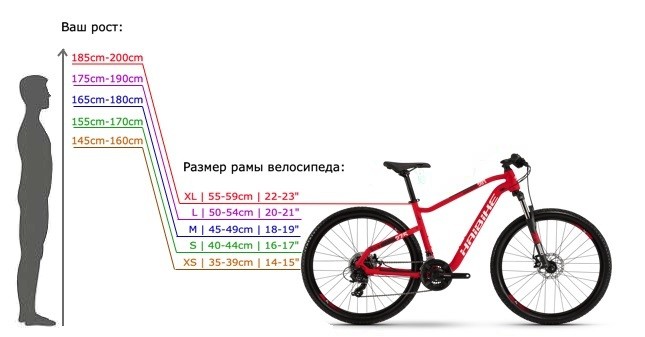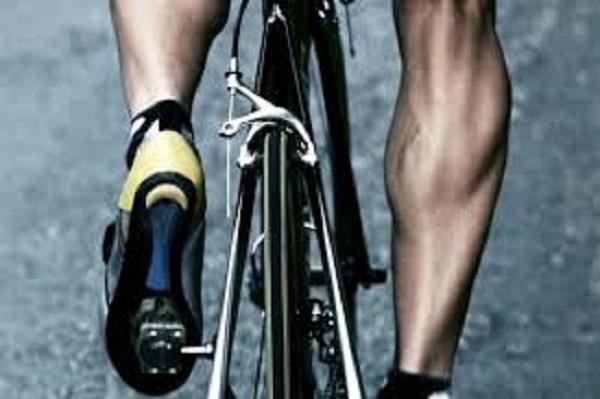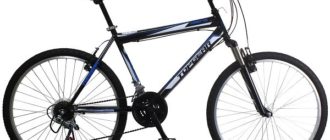How do you determine the frame size of a bicycle and what significance does this parameter have? It turns out that it is very important. It used to be that bicycles were the same: for a two-meter tall guy or a petite woman. For some reason, manufacturers considered all people the same – at least height and build were not taken into account.
Now everything is different: the designers and engineers began to take into account the physiological characteristics of riders and now in the documents to the bike are clearly spelled out parameters of the potential owner. Today, we’ll tell you what’s most important and what are the secondary values that can also influence your choice.
What the frame height affects
It is known that the correct position of the person on the bicycle allows not only to use the efficiency, but also to prevent such unpleasant consequences as back and joint pain after a long ride. The height of the bicycle frame matters in the following points:
- Transmission of force when pedaling. Correct pedaling position: the leg should be almost straight when reaching the lowest point.
- Safety. The cyclist should stand freely on the ground with the entire surface of the foot. There should be some space above the upper tube of the frame. This parameter helps minimize the likelihood of hitting the crotch on the metal tube.
- Back position. Regular, albeit brief, riding on the wrong bike can end up with unpleasant back effects. The cyclist should not strain too much trying to reach the handlebars – his back should be straight, and shoulders straightened.
- Maneuverability of the bike. The larger the frame of the bike, the less space is left for maneuvering.
As you can see, frame height is not such a minor parameter. It should not be ignored. Especially those who spend a lot of time in the company of their two-wheeled friend.
How to choose the right frame height
This parameter is determined by the length of the tube, located from the carriage unit and to the seatpost.
There are several ways to determine the appropriate parameter.
Size by height
This method cannot be considered 100% accurate because it does not take into account the overall proportions of the body, as well as the length of the arms and legs. But this method of determining the right size is good for understanding your size.
So, you need to measure your own height without shoes. Then, using the table “Bike length”, you can choose a suitable option. In the recommended classification, frame parameters are specified in inches, centimeters or conventional units.
Frames for larger bikes are assembled from stronger and thicker-walled tubes, so they can withstand the considerable weight of the cyclist. Smaller bikes tend to weigh 150-200 grams less than the adjacent, larger-sized bike.
Size classification according to the rider’s height:
| Height (cm) | Frame Size (inches) | Frame Size (cm) | frame size (cc) |
|---|---|---|---|
| 130-145 | 13″ | 33 | XS |
| 135-155 | 14″ | 35.6 | XS |
| 145-160 | 15″ | 38.1 | S |
| 150-165 | 16″ | 40.6 | S |
| 156-170 | 17″ | 43.2 | M |
| 167-178 | 18″ | 45.7 | M |
| 172-180 | 19″ | 48.3 | L |
| 178-185 | 20″ | 50.8 | L |
| 180-190 | 21″ | 53.3 | XL |
| 185-195 | 22″ | 55.9 | XL |
| 190-200 | 23″ | 58.4 | XXL |
| 195-210 | 24″ | 61 | XXL |
Length of leg
This is more accurate than the first method because it takes into account the parameters of a particular person. It is necessary to measure the length of the inner surface of the thigh from the heel to the crotch. It is important to take accurate measurements, for this you need:
- Stand up against the wall with your heels and buttocks touching the surface of the wall while keeping your knees straight.
- Measure the length of your inner thigh from the floor to the crotch in centimeters.
Next, you should use a formula to calculate the right size:
- Mountain bikes (MTB), hardtails, two-paddle models – leg length (cm) * 0.57 = frame size in centimeters.
- Road bikes and cyclocross bikes – Leg length (cm) * 0.66 = frame size in centimeters.
- Trekking bikes – Leg length (cm) * 0.63 = frame size in cm.
For example: Your inner thigh length is 79 cm. This means that the right frame height for you is – 79*0.57=45.03 (cm). This value should be rounded to 45 cm. To translate the result in inches, you need to divide this number by 2.54. This turns out to be 17.71 inches.
Adjustment method
Even knowing your height, inner thigh length and intended size of the bike frame, it is better to try on the bike and feel the fit on a particular model. The fact that the length of the upper tube and handlebar stem, the bend and tilt of the handlebar – these parameters may differ, due to which the fit of the rider will be uncomfortable.
Sometimes it does not save even the adjustment of individual parts and their replacement. In this case it is worth looking at another model, because the geometry of the frame can vary significantly depending on the manufacturer.
Correct body position
How do you know if the bike is right for you? There are times when the frame size of a bicycle perfectly matches the parameters of a particular person, that is, everything seems to fit, but the cyclist does not feel comfortable. And sometimes the fit is comfortable, but over time, cycling begins to hurt my hands, knees and back. What’s the matter?
It turns out that the bike was picked up and seems to be correct, but did not take into account the correct seating of the rider. What should it be? Let’s look at it in detail:
- The foot on the pedal at the lowest point should be slightly bent at the knee (the cyclist should not reach for the pedal).
- Your hips should not move apart as you pedal.
- The rider’s back on the bike should be straight with a slight forward slope. The shoulders are spread out.
- There should be a short distance from the top tube to the rider’s crotch while standing on the ground.
Choosing a suitable model of bicycle, you need to sit down on it, try to ride a few meters, check all the parameters and only then make a choice. It is necessary to take into account the distance from the saddle to the handlebars – the cyclist should not stretch too much to the control element. The rider should sit freely and comfortably.
Tables of frames for different types of bicycles
Bicycle manufacturers are interested in selling their products, so they try to cover as many potential buyers as possible, releasing each frame model in several sizes.
If your height suddenly does not fall under the table indications, you should choose a larger size. But if we’re talking about a bicycle with a shock absorber, this rule works in the opposite direction. And now let’s go over the most common frame sizes depending on the type of bike.
Mountain and city bikes
Use this table as a guide:
| Frame Size (inches) | Height (cm) | frame size (cm) | Frame Size (cc.) |
|---|---|---|---|
| 13″ | 130-145 | 33 | XS |
| 14″ | 135-155 | 35.6 | XS |
| 15″ | 145-160 | 38.1 | S |
| 16″ | 150-165 | 40.6 | S |
| 17″ | 156-170 | 43.2 | M |
| 18″ | 167-178 | 45.7 | M |
| 19″ | 172-180 | 48.3 | L |
| 20″ | 178-185 | 50.8 | L |
| 21″ | 180-190 | 53.3 | XL |
| 22″ | 185-195 | 55.9 | XL |
| 23″ | 190-200 | 58.4 | XXL |
| 24″ | 195-210 | 61 | XXL |
Folding models are an exception, because they come in one size and are designed for an average-sized cyclist of 1.55-1.85 meters tall.
Road and dirt bikes
The use of such models implies riding long distances on a relatively flat road. Therefore, the size of the frame for the cyclist is very important because the rider should feel comfortable and not so quickly get tired during the trip. The table will help you to choose the right size:
| Frame size (cm) | Height (cm) | frame size (c.u.) |
|---|---|---|
| 49-51 | 157-163 | XS |
| 51-54 | 163-170 | S |
| 55-57 | 170-178 | M |
| 57-59 | 178-183 | M/L |
| 58-60 | 183-190 | L |
| 61-63 | 190-198 | XL |
The frame size for the cyclist who participates in competitions is of great importance – even 1 cm here can seriously affect the outcome.
Folding bikes
These models are not designed for all riders. Riders of average size can ride them comfortably, if I can put it that way. This is a person of average build height of 155 to 185 cm. The fact is that the frames of folding models are available only in one size.
Kids Bikes
Choosing a two-wheeled vehicle for a child is not as easy as we would like it to be. The main difficulty lies in the fact that the little cyclist is constantly growing. Therefore, the modern classification of children’s bikes is based on the age of the baby and his growth. Rostovka children’s bicycles, developed directly by the manufacturers themselves:
| Child Age | Height (cm) | Wheel Diameter (inches) |
|---|---|---|
| 1-3 years | 75-95 | 12″ |
| 3-4 yrs. | 95-101 | 12″ |
| 4-6 years old | 101-115 | 16″ |
| 6-9 years old | 115-128 | 20″ |
| 9-13 years old | 126-155 | 24″ |
Given that children grow quite quickly, you should not take a bicycle to fit – otherwise the next season you will have to buy a new model. Another important parameter of children’s models – the ability to adjust the saddle and handlebar – this will “stretch” the life of the bicycle.
A child must necessarily sit on his future bike and ride it for a few meters. If the model is purchased just for training, it is still necessary to sit the baby and ask him to take a “working” position, that is, put his feet on the pedals and take hold of the wheel. The child’s posture is a serious issue, so it is definitely not worth neglecting the recommendations.
Tips and tricks
Select the appropriate height of the frame should not only the height and length of the legs – you should take into account other factors. For example, some manufacturers are developing their own size series, allowing you to make the right choice. But even the totality of all factors (height, leg length, recommendations of the manufacturer and the seller-consultant, personal trying on a bike) does not mean that you can pick a bike that matches your parameters by 100%. Why? Yes, because here you need to consider secondary factors:
- riding style;
- weight and overall build;
- saddle height;
- handlebar overhang.
When choosing a particular model, you need to consider the style of riding. If you like to ride on the relief terrain, to overcome off-road, it is recommended to choose a frame one size smaller than the recommended for you parameter. This allows you to feel more confident in particularly difficult areas. By the way, bicycles with a smaller frame are more maneuverable and stable. If you – the fan of leisurely and relaxed riding, feel free to take the bike, which corresponds to your size.
The handlebar stem is another parameter that you should be guided by when choosing a bike. There are a lot of values, so you will have to spend some time studying them. But it will allow you to choose the right model for a comfortable ride.
It is important to take into account the peculiarities of the body. And the matter here is not so much in the load, which falls on the construction of two-wheeled transport, as in their own comfort. Cyclists with an ordinary build should take their own size, without departing from generally accepted recommendations, but large people are advised to opt for models of a slightly smaller size.
Note that many models have the ability to adjust the height of the saddle and handlebar position. Some mountaineers can not adjust the stem, but you can raise or lower the saddle. If you see a model on which you cannot adjust the handlebar, do not rush to write it off. Such a feature is required by safety standards for fans of extreme skiing.
Conclusion
The problem of potential owners of new bikes is the wrong approach when choosing a model. They pay attention to the wheels, design, number of speeds, comfortable saddle, but not the size of the frame. And it is this parameter that determines how convenient the use of the bike will be.










